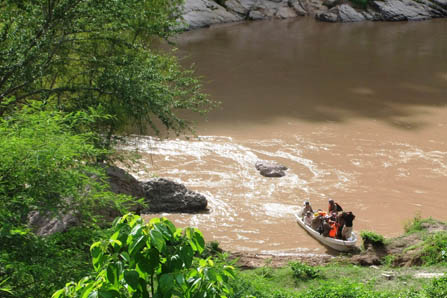In response to threat of Las Cruces Dam, Cora defend access to water and land in Nayar
The communal Cora refuse to accept the artificial reservoir in the San Pedro Mezquital River because it would inundate or put at risk 18 sacred sites and would put conditions on their traditional cultural practices.

The Federal Electricity Commision is planning to dam the
Río San Pedro Mezquital with the Las Cruces Hydroelectric Plant in the Cora territory (Photo: Agustín del Castillo).
PRESIDIO DE LOS REYES
This town embodies the history of the Nayeri population in their confrontations with the Mexican State, be it the colonial government of the 18th century, the liberal of the 19th, or the versions born of the Revolution in the last century.
Today, reflected in the cobbled and dusty streets of this sweltering hamlet is the division caused by the latest government megaproject: the Las Cruces hydroelectric dam, with which the Federal Electricity Commission (CFE) is planning to dam the San Pedro Mezquital River in the ancestral territory of the Cora.
The proposal puts at risk up to 18 sites recognized as ancient and sacred but which outsiders have not bothered to try to understand.
The town itself is divided, first by the river, and then by the history of mestizaje (the integration of races or cultures). Almost all the mestizos (mixed-race) individuals, now with two generations behind them, are completely backing a project that promises thousands of jobs (the majority of these short-term), better infrastructure, social and health care assistance.
Historically from another age but geographically less than a half mile away from the new bridge site are the descendents of the original Cora people. Beyond their traditional suspicion and mistrust, the Cora see the artificial reservoir as heralding the destruction of part of their world, yet one more step in the prolonged death of a culture whose mountain villages no longer are the impenetrable frontier they once were.
Across the gentle and fertile valleys of the Nayarit coast, where artisanal fishermen live off of the resources of the National Wetlands delta, a highway, still incomplete, passes westward through Estación Ruíz towards the mountains of the Gran Nayar. This is the route to Presidio de Las Reyes and the indigenous community of San Pedro Ixcatán, one of the nine towns that comprise the Cora world.
Because of its proximity to the grasslands, there is a strong constituency of farmers who have settled there and hold agrarian rights. They are not always in favor of local interests, which has resulted in conflicts, such as the one this past October 12.
"The Federal Electricity Commission has taken advantage of this in order to try to divide us; they promise everything but it is conditioned on a “yes” vote. And if that doesn't work, they fabricate agreements, meetings, and a whole string of tricks with the help of the Agrarian Procurator's Office (PA) and the state government", points out the delegate for the Nayeri Indigenous Council, Julián López Canaré.
"A megaproject like this expropriates a large quantity of land that is part of our ancestral territory, which is in itself very small given all of the past invasions. But it is also an attempt to privatize the water. We believe that for our culture to have continuity we need to decide for ourselves how to utilize of our land and to debate what we think development should be", he adds.
The communal Cora have known of the project since 2008, but it was just a few months ago that they tried to seek an agreement.
After long consultations with those in the mountains, and with academic allies and civil society, the indigenous authorities decided "No" on April 7, 2013.
The pushback was strong: on April 14, government supported organizations and the PA attached the signature sheets of voters from the meeting, and with their mestizo allies (not all of them) granted permission to continue exploration work of the San Pedro River. The payoffs were obvious, but just to name one example, thirty vials of scorpion anti-venom that had been delivered to the local clinic disappeared after three days, "well they told us that it was needed elsewhere", said one inhabitant.
The AP’s Chief of Residency, Rómulo Pérez Cruz, admitted that they couldn't actually certify the meeting since it lacked a quorum because, according to the National Agrarian Register, San Pedro Ixcatán has 920 members with current rights, but it turned out that 515 dead people still appear as voters.
Ever since the ejido of this Kafkaesque community was initially certified, the 515 had been repeatedly sanctioned for being absent. After some time, their continued absence was ignored and they were put back on the rolls. But there’s not a sign of their souls. "The CFE will use anything", warns Jorge Alberto Avalos, professor of Tuxpan.
The area’s rough terrain permitted the Cora to resist the European conquest for two centuries. But today, when engineers have discovered the ideal conditions in these mountains for producing electricity because of a 607 foot elevation change, this same mountain terrain seems to be changing a path which has almost never been promising for the Cora.
And not only is it a matter for the Cora. The future of fishermen upriver in the estuaries of the National Wetlands is also at stake. For them, the dam implies the loss of the equilibrium in the contributions of fresh and salt water; a disruption in travel corridors for mountain species, and the death of the mangroves which are the cradle of biodiversity.
